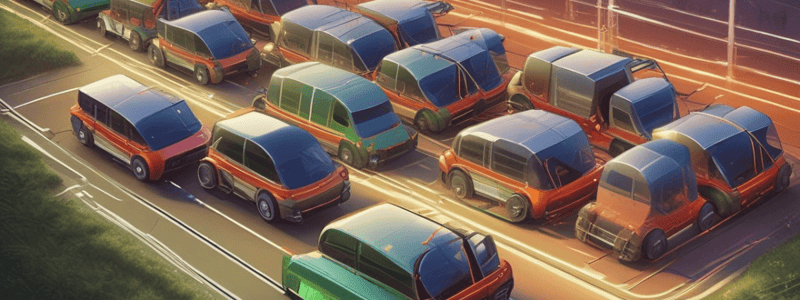Podcast
Questions and Answers
What can cause a Lithium-Ion Battery (LIB) to rupture and disperse toxic flammable gases?
What can cause a Lithium-Ion Battery (LIB) to rupture and disperse toxic flammable gases?
- Any of thermal conditions, physical impact, electrical over-charging, or drying after being wet (correct)
- Only physical impact or electrical over-charging
- Only drying after being wet or thermal conditions
- Only thermal conditions
What should be done with a LIB that has been submerged in saltwater?
What should be done with a LIB that has been submerged in saltwater?
- Use it after cleaning
- Try to dry it
- Discard it immediately (correct)
- Store it in a dry place
What can happen to a LIB that has entered thermal runaway?
What can happen to a LIB that has entered thermal runaway?
- It will only produce flammable gases
- It will stop functioning but not ignite
- It will automatically shut down
- It may explode violently and produce toxic gases (correct)
Why should water not be used to extinguish a LIB fire?
Why should water not be used to extinguish a LIB fire?
What can happen to a LIB after a fire has been extinguished?
What can happen to a LIB after a fire has been extinguished?
What is true about the gases produced by a LIB in thermal runaway?
What is true about the gases produced by a LIB in thermal runaway?
What is the primary risk related to Lithium-Ion Batteries (LIBs)?
What is the primary risk related to Lithium-Ion Batteries (LIBs)?
What is the main concern for firefighter safety regarding LIBs?
What is the main concern for firefighter safety regarding LIBs?
What is an example of an Energy Storage System (ESS)?
What is an example of an Energy Storage System (ESS)?
What is the main reason for the increase in fires involving LIBs?
What is the main reason for the increase in fires involving LIBs?
What is an example of a type of Energy Storage System (ESS)?
What is an example of a type of Energy Storage System (ESS)?
What is the result of thermal runaway in a lithium-ion cell?
What is the result of thermal runaway in a lithium-ion cell?
What is the definition of an Electric Vehicle (EV)?
What is the definition of an Electric Vehicle (EV)?
What is the trend of fires involving LIBs?
What is the trend of fires involving LIBs?
Flashcards are hidden until you start studying
Study Notes
Energy Storage Systems (ESS)
- A battery or group of batteries assembled to store energy for later electrical energy supply
- Types of ESS: walk-in container system, outdoor cabinet, indoor facility (residential, commercial, public utility), large and small vehicle batteries
Electric Vehicle (EV)
- An automobile, e-scooter, e-bike, or other vehicle with an electric motor fully or partially powered by batteries
Thermal Runaway
- A phenomenon where a lithium-ion cell enters an uncontrollable, self-heating state
- Risks associated with thermal runaway: dispersion of gases, ejection of shrapnel and/or particulates, fire
Background
- Increased use of lithium-ion batteries (LIBs) adds concerns for firefighter safety and incident mitigation
- LIBs are used in various consumer products, from small devices to large-scale power grid support
- Fires involving LIBs are increasing, resulting in fatalities, and can intensify existing fires
Hazards
- LIBs may rupture and disperse toxic, flammable gases, and/or explode violently due to:
- Thermal conditions (hot or cold, temperature changes)
- Physical damage (impact, crush, pierce)
- Electrical issues (over-charging, forced discharge, internal defects, internal short circuiting)
- Drying after being submerged in water (especially saltwater)
Safety Precautions
- Discard LIBs submerged in saltwater immediately
- Be cautious of re-ignition, which can occur minutes, hours, or even days after visible fire has been extinguished
- Never compromise the container to allow water to enter the case
Studying That Suits You
Use AI to generate personalized quizzes and flashcards to suit your learning preferences.




